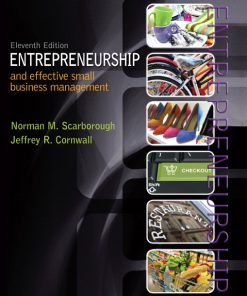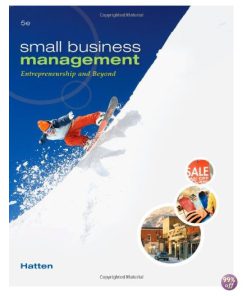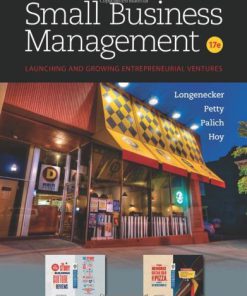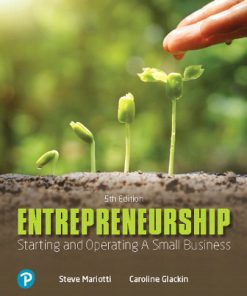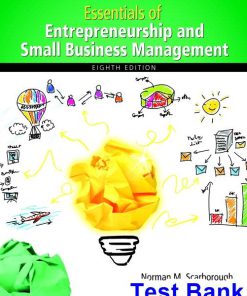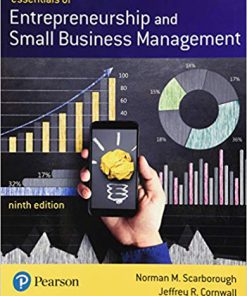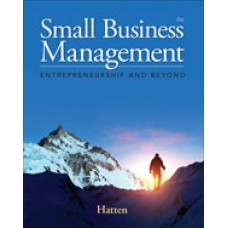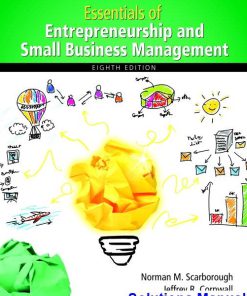Entrepreneurship and Small Business Management 2nd Edition Mariotti Test Bank
$35.00 Original price was: $35.00.$26.50Current price is: $26.50.
Entrepreneurship and Small Business Management 2nd Edition Mariotti Test Bank
This is completed downloadable of Entrepreneurship and Small Business Management 2nd Edition Mariotti Test Bank
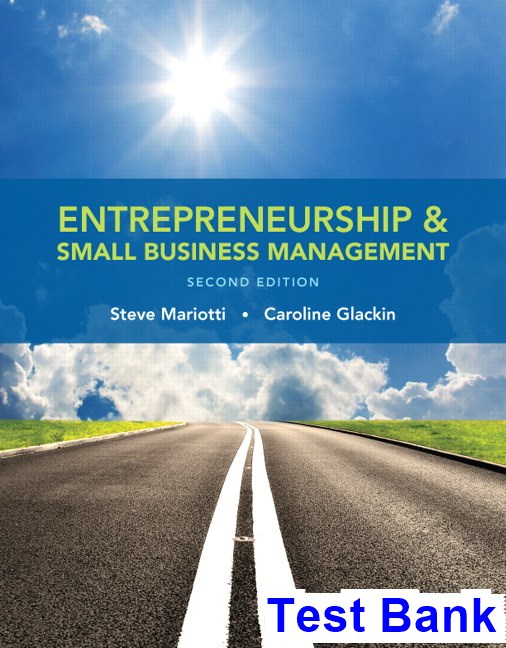
Product Details:
- ISBN-10 : 0133767183
- ISBN-13 : 978-0133767186
- Author: Steve Mariotti (Author), Caroline Glackin (Author)
Written by award-winning experts, Steve Mariotti and Caroline Glackin, Entrepreneurship and Small Business Management presents complex economic, financial and business concepts in a manner easily understood by a variety of students.
Based on a proven curriculum from the Network for Teaching Entrepreneurship (NFTE), it is organized to follow the life-cycle of an entrepreneurial venture–from concept through implementation to harvesting or replication. Filled with examples from a broad range of industries, it moves further into the entrepreneurial process–discussing the business plan and also the unique aspects of managing and growing entrepreneurial ventures and small businesses.
This program will provide a better teaching and learning experience―for you and your students. Here’s how:
- Help Students Apply Knowledge from the Text to the Real World: Cases give students the opportunity to solve real-world challenges.
- Present Special Insights on Presenting and Writing a Business Plan: Go beyond formulating a business plan to include critical topics of management, marketing and operations.
- Guide Student’s Learning: A proven curriculum builds on the expertise of the authors and the Network for Teaching Entrepreneurship (NFTE) to teach the nuts and bolts of how to start and operate an entrepreneurial small business.
Table of Content:
- UNIT 1 Entrepreneurial Pathways
- Chapter 1 Entrepreneurs Recognize Opportunities
- Learning Objectives
- Entrepreneurship Defined
- What Is an Entrepreneur?
- The Economic Questions
- Voluntary Exchange
- Benefits and Challenges of Free Enterprise
- What Is a Small Business?
- Why Become an Entrepreneur?
- The Desire to Make Money Is Not the Only Reason to Start a Business
- Definitions of Success—Monetary and Other
- Taking the Long View
- Benefits and Costs of Becoming an Entrepreneur
- Cost/Benefit Analysis
- Opportunity Cost
- Seeking Advice and Information to Succeed
- Entrepreneurial Options
- How Do Entrepreneurs Find Opportunities to Start New Businesses?
- Entrepreneurs Creatively Exploit Changes in Our World
- Where Others See Problems, Entrepreneurs Recognize Opportunities
- Train Your Mind to Recognize Business Opportunities
- Entrepreneurs Use Their Imaginations
- An Idea Is Not Necessarily an Opportunity
- Opportunity Is Situational
- The Five Roots of Opportunity in the Marketplace
- Integrating Internal and External Opportunities
- Establishing Strategies
- Paths to Small Business Ownership
- Securing Franchise Rights
- Buying an Existing Business
- Licensing Technology
- Do Not Take Unfair Advantage of Someone Else’s Creativity
- The Many Faces of Entrepreneurship
- Gazelles
- Microenterprises
- Mainstream Small Firms
- Making the Business Work Personally and Professionally
- A Business Must Make a Profit to Stay in Business
- Profit Is the Sign That the Entrepreneur Is Adding Value
- Profit Results from the Entrepreneur’s Choices
- Seven Rules for Building a Successful Business
- The Team Approach
- Chapter Summary
- Key Terms
- Entrepreneurship Portfolio
- Critical Thinking Exercises
- Key Concepts Questions
- Application Exercises
- Exploring Your Community
- Exploring Online
- Case Study Urban Decay: Finding an Entrepreneurial Opportunity
- Case Study Analysis
- Case Sources
- Case Study Foursquare
- The Founders
- Creating at the Kitchen Table
- The App
- Financing
- Cofounder Perspective
- Case Study Analysis
- Case Sources
- Chapter 2 Franchising
- Learning Objectives
- Defining Franchising
- What Are the Types of Franchises?
- Facts to Know Before Investing in a Franchise
- Positive Aspects of Franchises
- Start-Up Assistance
- Instant Recognition
- Purchasing Power
- Advertising and Promotional Support
- Operating Guidelines and Assistance
- Record of Success
- Drawbacks of Buying a Franchise
- Constraints on Creativity and Freedom
- Costs
- Standards and Termination
- The Structure of the Franchise Industry
- Franchising and the Law
- Steps for Franchise Selection
- Exploring Global Franchising Opportunities
- Chapter Summary
- Key Terms
- Entrepreneurship Portfolio
- Critical Thinking Exercises
- Key Concept Questions
- Application Exercise
- Exploring Online
- Case Study SarahCare of Snellville—A Franchise Opportunity in Adult Day Care
- Case Study Analysis
- Case Sources
- Case Study Pietsch Siblings: Wahoo’s Fish Taco® Franchisees
- How Wahoo’s Began
- Wahoo’s Comes to Hawaii
- Learning Valuable Lessons
- Marketing the Business
- Wahoo’s Franchise Information
- Case Study Analysis
- Case Sources
- Chapter 3 Finding Opportunity in an Existing Business
- Learning Objectives
- Reasons to Buy an Existing Business
- Quicker, Easier Start-Up
- Reduced Risk
- Bargain Potential
- Your Knowledge Can Be Beneficial
- Potential Pitfalls of Buying an Existing Business
- Investment Requirements
- Buying Someone Else’s Problems
- Business Is Not a Good Fit
- Finding and Evaluating Available Businesses
- Sources of Existing Businesses
- Due Diligence—Reality versus the Story
- Determining the Value of a Business
- Negotiating and Closing a Purchase
- Buying into a Business over Time
- Family Business as an Entrepreneurial Opportunity
- Chapter Summary
- Key Terms
- Entrepreneurship Portfolio
- Critical Thinking Exercises
- Key Concept Questions
- Application Exercise
- Exploring Online
- Case Study A Family Affair
- Case Study Analysis
- Case Source
- Case Study Krispy Kreme Doughnuts®
- Prospects and Risks in Buying a Business
- Building on a Secret Formula
- Continued Growth and Success
- The Wrong Fit
- Getting Back on Track
- Going Public: Transferring Ownership Again
- Earning a Place in History
- Case Study Analysis
- Case Sources
- Chapter 4 The Business Plan: Road Map to Success
- Learning Objectives
- Feasibility Analysis: Does My Idea Work?
- Analyzing Product and/or Service Feasibility
- Analyzing Market and Industry Feasibility
- Existing Competitive Rivalry
- Barriers to Entry
- Threat of Substitutes
- Supplier Power
- Buyer Power
- Analyzing Financial Feasibility
- Creating a Business Model Canvas
- What Is a Business Plan?
- Why Do You Need a Business Plan?
- Writing a Business Plan Early Will Save You Time and Money
- Your Business Plan Is the Key to Raising Capital
- The Business Plan Is an Operations Guide
- Business Plan Components
- Cover Page and Table of Contents
- Executive Summary: A Snapshot of Your Business
- Mission, Vision and Culture
- Company Description—Background and Track Record
- Opportunity Analysis and Research: Testing Ideas
- Marketing Strategy and Plan: Reaching Customers
- Management and Operations: Making the Plan Happen
- Financial Analysis and Projections: Translating Action into Money
- Funding Request and Exit Strategy: The Ask and the Return
- Appendices: Making the Case in Greater Detail
- Business Plan Suggestions
- Presenting Your Business Plan
- Business Plan and Venture Competitions
- Chapter Summary
- Key Terms
- Entrepreneurship Portfolio
- Critical Thinking Exercises
- Key Concept Questions
- Application Exercises
- Exploring Online
- In Your Opinion
- Mission Statement
- Executive Summary
- Company Story
- The Product
- Production and Manufacturing
- Market Opportunity
- Beyond Snapple–The Emerging Market for Quality Bottled Tea
- Profile of Target Customer
- Market Research
- Market Response
- Marketing & Distribution
- National natural/specialty foods channels
- Higher end food service
- Promotion
- Packaging and Pricing
- International Markets
- Product Development and Future Products
- Management
- Statement and Aspirations for Social Responsibility
- Financial Statements–Year-to-Date and Projections
- Exhibit E Honest Tea Income Statement 1998
- Exhibit F Honest Tea Income Statement Projections 1999
- The Investment Opportunity4
- The Offering
- Financing History
- Exit Strategies
- Investment Risks
- Competitive Advantage
- A Parting Thought
- UNIT 1 Entrepreneurial Pathways
- SPANX—Idea to Entrepreneurial Opportunity
- Seeing Opportunity in a Problem
- The Woman Behind the Brand
- Resources
- Team
- Spanx Expands into Shape Wear, Swimwear, and Hosiery
- Turning Profits into Philanthropy
- Case Study Analysis
- Case Sources
- UNIT 2 Who are Your Customers?
- Chapter 5 Creating Business from Opportunity
- Learning Objectives
- Apple and the Personal Computer
- Business Definition
- What Sort of Organization Do You Want?
- Your Company’s Core Values
- Your Company’s Mission Is to Satisfy Customers
- Your Company’s Vision Is the Broader Perspective
- Your Company’s Culture Defines the Work Environment
- The Decision Process
- Your Competitive Advantage
- Find Your Competitive Advantage by Determining What Consumers Need and Want
- You Have Unique Knowledge of Your Market
- The Six Factors of Competitive Advantage
- Is Your Competitive Advantage Strong Enough?
- Checking Out the Competition
- The Most Chocolate Cake Company
- Competitive Strategy: Business Definition and Competitive Advantage
- Strategy versus Tactics
- Feasibility Revisited: The Economics of One Unit as a Litmus Test
- Defining the Unit of Sale
- Cost of Goods Sold and Gross Profit
- Your Business and the Economics of One Unit
- The Cost of Direct Labor in the EOU—An Example
- Hiring Others to Make the Unit of Sale
- Going for Volume
- Chapter Summary
- Key Terms
- Entrepreneurship Portfolio
- Critical Thinking Exercises
- Key Concept Questions
- Application Exercises
- Exploring Online
- BizBuilder Business Plan Questions
- 1.0 Executive Summary
- 2.0 Mission, Vision, and Culture
- Case Study Happy Belly Curbside Kitchen—Finding Opportunity in Healthy Food
- Case Study Analysis
- Case Sources
- Case Study Translating Talent in Three Businesses
- Sol y Canto
- MusicAmador
- Amador Bilingual Voice-Overs
- Organization and Culture
- Case Study Analysis
- Case Sources
- Chapter 6 Exploring your Market
- Learning Objectives
- Markets and Marketing Defined
- A Business That Markets versus a Market-Driven Business
- Market and Marketing Research Support Success
- Research Your Market Before You Open Your Business
- Types and Methods of Research
- Getting Information Directly from the Source: Primary Research
- Getting Information Indirectly: Secondary Research
- Market Research Helps You Know Your Customer
- Customer Research
- Industry Research: The 50,000-Foot Perspective
- Make Market Research an Integral Part of Your Business
- How Customers Decide to Buy
- Owning a Perception in the Customer’s Mind
- Features Create Benefits
- Home Depot: Teaching Customers So They Will Return
- Which Segment of the Market Will You Target?
- Successful Segmenting: The Body Shop
- Applying Market Segmentation Methods
- The Product Life Cycle
- Is Your Market Saturated?
- Market Positioning: Drive Home Your Competitive Advantage
- Developing a Marketing Plan
- Chapter Summary
- Key Terms
- Entrepreneurship Portfolio
- Critical Thinking Exercises
- Key Concept Questions
- Application Exercises
- Exploring Online
- BizBuilder Business Plan Questions
- 4.0 Opportunity Analysis and Research
- 4.1 Industry Analysis
- 4.2 Environmental Analysis
- 4.3 Competitive Analysis
- Case Study American Electrical: Understanding the Market Sparks a New Venture
- Case Study Analysis
- Case Study Russell Simmons, Hip-Hop Entrepreneur
- Window of Opportunity
- Marketing Insight: Authenticity Matters
- Simmons’s Empire Grows
- Case Study Analysis
- Case Sources
- UNIT 2 Opportunity Assessment
- Kitchen Arts & Letters, Inc.—An Independent Bookstore Defies Industry Odds
- Not Just a Cookbook Store
- Serving up Customer Satisfaction
- Not Every Book Is for Sale
- A Market Divided
- Bookstore Industry Background
- Case Study Analysis
- UNIT 3 Integrated Marketing
- Chapter 7 Developing the Right Marketing Mix and Plan
- Learning Objectives
- The Four Marketing Factors
- Product: What Are You Selling?
- Create Your Total Product or Service Concept
- Focus Your Brand
- Ford’s Costly Failure: The Edsel
- Ford’s Focus on Success: The Mustang
- How to Build Your Brand
- Price: What It Says about Your Product
- Place: Location, Location, Location!
- Promotion: Advertising ∙ Publicity
- The Fifth P: Philanthropy
- Cause-Related Marketing
- Gaining Goodwill
- Not-for-Profit Organizations
- Teach for America and Upromise
- What Entrepreneurs Have Built
- You Have Something to Contribute
- Developing a Marketing Plan
- Marketing Analysis
- Marketing as a Fixed Cost
- Calculate Your Breakeven Point
- Breakeven Analysis for an Artist
- Breakeven Analysis of a Restaurant
- Chapter Summary
- Key Terms
- Entrepreneurship Portfolio
- Critical Thinking Exercises
- Key Concept Questions
- Application Exercise
- Exploring Online
- BizBuilder Business Plan Questions
- 5.0 Marketing Strategy and Plan
- 5.1 Products/Services
- 5.2 Pricing
- 5.3 Promotion
- 5.4 Place
- Case Study 23andMe
- Case Study Analysis
- Case Sources
- Case Study Malia Mills: Love Thy Differences
- The Polaroid Project
- Place Matters: Setting the Right Tone
- The Price/Production Connection
- Smart Selling Requires Trial and Error
- Promotions: Getting the Word Out
- Case Study Analysis
- Case Sources
- Chapter 8 Pricing and Credit Strategies
- Learning Objectives
- Pricing: Image, Value, and Competition Together
- Strategies and Tactics for Effective Pricing
- Value Pricing Strategy
- Prestige Pricing Strategy
- Cost-Plus Pricing Strategy
- Penetration Pricing Strategy
- Skimming Price Strategy
- Meet-or-Beat-the-Competition Pricing Strategy
- Follow-the-Leader Pricing Strategy
- Personalized Pricing Strategy
- Variable Pricing Strategy
- Price Lining Strategy
- Pricing Varies by the Type of Firm
- Pricing Techniques for Manufacturers
- Pricing Techniques for Wholesalers
- Pricing Techniques for Retailers
- Keystoning—The Retailer’s Rule of Thumb
- Pricing Techniques for Service Businesses
- Pricing Principles
- Extending Credit to Customers
- The Costs and Benefits of Credit
- Types of Credit
- Credit Cards
- Installment Credit
- Trade Credit
- Credit’s Impact on Pricing
- Managing the Credit Process
- Sources of Credit Information
- Aging of Receivables
- Credit Regulation
- Discounts, Incentives, and Other Price Adjustments
- Chapter Summary
- Key Terms
- Entrepreneurship Portfolio
- Critical Thinking Exercises
- Key Concept Questions
- Application Exercises
- Exploring Online
- BizBuilder Business Plan Questions
- Case Study Credit Policies—Harold Import Company
- Case Study Analysis
- Case Source
- Case Study Texas Jet—Premium Pricing for Premium Service8
- Lead with Service and Turn Time into an Asset
- Price it High
- Case Study Analysis
- Chapter 9 Integrated Marketing Communications
- Learning Objectives
- Use Integrated Marketing Communications for Success
- Reinforce the Company’s Unique Selling Proposition
- Promotional Planning
- Create a Promotional Strategy Using Promotions Opportunity Analysis
- Determine a Promotional Budget
- Percentage of Sales
- Competitive Spending
- Excess Funds
- Objective and Task
- The Advertising Advantage
- Advertising Agencies and Freelancers
- Types of Advertising
- Media Planning and Buying: Focus on Your Customer
- The Media
- Broadcast Media
- Print Media
- Outdoor Advertising (Out-of-Home Advertising)
- Advertising Measurement: Beyond Reach and Frequency
- Marketing Materials Should Reinforce Your Competitive Advantage
- Collateral Materials: Print and Multimedia
- Sales-Promotion Solutions
- When to Use Promotional Tools
- Advertising Specialties
- Trade Show Exhibits
- Mall Carts or Kiosks
- Alternative Marketing
- Other Media Venues
- Database and Direct-Response Marketing
- Data Collection, Coding, and Mining
- Marketing Communications Driven by Databases
- E-mail Marketing
- Direct Mail
- Catalogs
- Coupons
- Infomercials and Direct-Response Commercials
- Telemarketing
- E-Active Marketing
- Publicity Potential
- Generating Publicity
- Telling the Story
- Sample Press Release
- Follow Up a Press Release
- Public Relations
- Special Events
- Sponsorships
- Networking
- Public Speaking
- Chapter Summary
- Key Terms
- Entrepreneurship Portfolio
- Critical Thinking Exercises
- Key Concept Questions
- Application Exercises
- Exploring Your Community
- Exploring Online
- BizBuilder Business Plan Questions
- 5.0 Marketing Strategy and Plan
- 5.3 Promotion
- Case Study Dr. Farrah Gray: Young Millionaire, Entrepreneur, and Philanthropist
- Case Study Analysis
- Case Source
- Case Study eHarmony
- Turn a Small Idea into a Big One
- Charge More and Demand More Than Your Competition
- Find an Advertising Strategy
- Case Study Analysis
- Chapter 10 Marketing Globally
- Learning Objectives
- Reasons to Market Globally
- Market Expansion
- Access to Resources
- Cost Reduction
- Location-Specific Advantages
- Improving Quality Levels
- Strategy Options for Global Ventures
- Importing
- Exporting
- Cymbals Heard Globally
- Strategic Alliances
- International Licensing
- International Franchising
- International Facilities
- Challenges to International Trade
- Economic Risk
- Political Risk
- Organizational Capacity
- Legal and Regulatory Barriers
- Tariffs
- Quotas
- Embargoes
- Dumping
- Cultural and Ethnic Considerations
- Support for Global Ventures
- Market Research, Analysis, Planning, and Readiness
- Customer and Partner Identification and Relationship Building
- Financing
- Letters of Credit
- Working Capital Loan Program (EWCP)
- Export Express Loan Program
- International Trade Loans
- Ex-Im Bank’s Export Working Capital Guarantee Program
- Export Medium-Term Delegated Authority Program
- Ex-Im Bank’s Loan Guarantee
- Trade Agreements Influence Global Marketing
- Chapter Summary
- Key Terms
- Entrepreneurship Portfolio
- Critical Thinking Exercises
- Key Concept Questions
- Application Exercise
- Exploring Online
- BizBuilder Business Plan Questions
- 3.0 Company Description
- 4.0 Opportunity Analysis and Research
- 4.2 Environmental Analysis
- 5.0 Marketing Strategy and Plan
- 5.4 Place
- Case Study Luggage Concierge
- Case Study Analysis
- Case Sources
- Case Study Lourdes “Chingling” Tanco, MIDA Trade Ventures, Inc.
- A Global Seafood Legacy
- In the Beginning
- Keys to Global Success
- Case Study Analysis
- Case Sources
- Chapter 11 Smart Selling and Effective Customer Service
- Learning Objectives
- Selling Skills Are Essential to Business Success
- Selling Is a Great Source of Market Research
- The Essence of Selling Is Teaching
- The Principles of Selling
- Make a Good Personal Impression
- Know Your Product or Service
- Believe in Your Product or Service
- Know Your Field
- Know Your Customers
- Prepare Your Sales Presentation
- Think Positively
- Keep Good Records
- Make No Truly “Cold Calls”
- Make an Appointment
- Treat Everyone You Sell to Like Gold
- The Sales Call
- Electronic Mail, Blogs, and Social Networks
- Prequalify Your Sales Calls
- Focus on the Customer
- The Eight-Step Sales Call
- Three Call Behaviors of Successful Salespeople
- Analyze Your Sales Calls to Become a Star Salesperson
- Turning Objections into Advantages
- Use Technology to Sell
- Successful Businesses Need Customers Who Return
- Customer Service Is Keeping Customers Happy
- The Costs of Losing a Customer
- Customer Complaints Are Valuable
- Customer Relationship Management Systems
- Why Does CRM Matter?
- Components of CRM for the Small Business
- How Technology Supports CRM
- Chapter Summary
- Key Terms
- Entrepreneurship Portfolio
- Critical Thinking Exercises
- Key Concept Questions
- Application Exercises
- Exploring Your Community
- BizBuilder Business Plan Questions
- 5.0 Marketing Strategy and Plan
- 5.1 Products/Services
- 5.3 Promotion
- Case Study BNI—Building Businesses through Networking
- Case Study Analysis
- Case Sources
- Case Study Amazing Customer Service Propels Amazon
- A Culture of Service
- Swimming Against the Current
- Using Technology to Sell
- Actively Seeking Customer Feedback
- The Total Customer Experience
- Case Study Analysis
- Case Sources
- UNIT 3 Integrated Marketing
- Empact: Making an Impact for EntrepreneUrs
- Making a Strategic Pivot
- Marketing for the Tour
- Empact Showcases: Building Recognition, Market, and a Supply of Speakers
- Empact Summits
- Guest Author: Building Credibility and Broadening Reach
- Social Media
- Recognition
- Case Study Analysis
- Case Sources
- UNIT 4 Show Me the Money: Finding, Securing, and Managing It
- Chapter 12 Understanding and Managing Start-Up, Fixed, and Variable Costs
- Learning Objectives
- What Does It Cost to Operate a Business?
- Start-Up Investment
- Brainstorm to Avoid Start-Up Surprises
- Keep a Reserve Equal to One-Half the Start-Up Investment
- Predict the Payback Period
- Estimate Value
- Fixed and Variable Costs: Essential Building Blocks
- Calculating Critical Costs
- Calculating Total Gross Profit (Contribution Margin)
- Calculating EOU When You Sell Multiple Products
- Fixed Operating Costs
- Fixed Operating Costs Can Change Over Time
- Allocate Fixed Operating Costs Where Possible
- The Dangers of Fixed Costs
- Using Accounting Records to Track Fixed and Variable Costs
- Three Reasons to Keep Good Records Every Day
- Use Accounting Software
- Keep Receipts and Invoices
- Keep at Least Two Copies of Your Records
- Use Business Accounts for Business Expenses
- Avoid Using Cash for Business.
- Deposit Money from Sales Right Away.
- Cash versus Accrual Accounting Methods
- Recognizing Categories of Costs
- Chapter Summary
- Key Terms
- Entrepreneurship Portfolio
- Critical Thinking Exercises
- Key Concept Questions
- Application Exercise
- Exploring Your Community
- Exploring Online
- In Your Opinion
- BizBuilder Business Plan Questions
- 7.0 Financial Analysis and Projections
- 7.1 Sources and Uses of Capital
- 7.2 Cash Flow Projections
- Case Study A Cool Business—MooBella, LLC
- Case Study Analysis
- Case Sources
- Case Study Damon White Party Promotions5
- The Problem
- Problems Can Lead to Opportunities
- Getting Organized
- Damon Investigates His Costs
- The Party
- Keeping Good Records
- Future Possibilities
- Case Study Analysis
- Chapter 13 Using Financial Statements to Guide a Business
- Learning Objectives
- Scorecards for the Entrepreneur: What Do Financial Statements Show?
- Income Statements: Showing Profit and Loss Over Time
- Parts of an Income Statement
- A Basic Income Statement
- The Double Bottom Line
- An Income Statement for a More Complex Business
- The Balance Sheet: A Snapshot of Assets, Liabilities, and Equity at a Point in Time
- Short- and Long-Term Assets
- Current and Long-Term Liabilities
- The Balance Sheet Equation
- The Balance Sheet Shows Assets and Liabilities Obtained through Financing
- The Balance Sheet Shows How a Business Is Financed
- Analyzing a Balance Sheet
- Depreciation
- Financial Ratio Analysis: What Is It and What Does It Mean to You?
- Income Statement Ratios
- Return on Investment
- Return on Sales
- Common-Sized Statement Analysis
- Balance-Sheet Analysis
- Quick and Current Ratios
- Debt Ratios: Showing the Relationship between Debt and Equity
- Operating-Efficiency Ratios
- Chapter Summary
- Key Terms
- Entrepreneurship Portfolio
- Critical Thinking Exercises
- Key Concept Questions
- Application Exercise
- Exploring Online
- BizBuilder Business Plan Questions
- 7.0 Financial Analysis and Projections
- 7.3 Balance Sheet Projections
- 7.4 Income Statement Projections
- 7.5 Breakeven Analysis
- 7.6 Ratio Analysis
- 7.7 Risks and Assumptions
- Case Study Gentle Rest Slumber, LLC: Using Financials to Build Employee Performance4
- Case Study Analysis
- Case Study Portland Freelancers’ Café: Amy and Steve’s Business Idea5
- We Can Do Better
- Deluxe Purchases
- Financing
- Computer Glitch
- Business Troubles Brew
- Amy and Steve’s EOU
- In Hot Water
- Changes in the Environment
- Amy and Steve’s EOU Revisited
- An Uncertain Future
- Case Study Analysis
- Chapter 14 Cash Flow and Taxes
- Learning Objectives
- Cash Flow: The Lifeblood of a Business
- The Income Statement Does Not Show Available Cash
- Rules to Keep Cash Flowing
- Noncash Expenses Can Distort the Financial Picture
- The Working Capital Cycle
- The Cyclical and Seasonal Nature of Cash Flow
- Reading a Cash Flow Statement
- The Cash Flow Equation
- Forecasting Cash Flow: The Cash Budget
- Creating a Healthy Cash Flow
- Managing Inventory to Manage Cash
- Freeing Up Cash by Reducing Inventory
- Tracking Inventory
- Controlling Inventory Levels
- Managing Receivables to Manage Cash
- The Cash Effects of Accounts Receivable
- The Life Cycle of Accounts Receivable
- The Financing of Accounts Receivable
- Managing Accounts Payable to Manage Cash
- Negotiating Payment
- Timing Payables
- Capital Budgeting and Cash Flow
- The Burn Rate
- The Value of Money Changes Over Time
- The Future Value of Money
- The Present Value of Money
- Taxes
- Cash Flow and Taxes
- Filing Tax Returns
- Collecting Sales Tax
- Tax Issues for Different Legal Structures
- Make Tax Time Easier by Keeping Good Records
- Chapter Summary
- Key Terms
- Entrepreneurship Portfolio
- Critical Thinking Exercises
- Key Concept Questions
- Application Exercise
- Exploring Online
- BizBuilder Business Plan Questions
- 7.0 Financial Analysis and Projections
- 7.2 Cash Flow Projections
- 7.7 Risks and Assumptions
- Case Study Holterholm Farms—Radical Change for Maximum Impact
- Case Study Analysis
- Case Sources
- Case Study Managing Cash: CakeLove and Love Café
- Case Study Analysis
- Case Sources
- Chapter 15 Financing Strategy: Debt, Equity, or Both?
- Learning Objectives
- Going It Alone versus Securing Financing
- How Often Do Small Businesses Really Fail?
- What Is the Best Type of Financing for You and Your Business?
- Gifts and Grants
- Debt Financing
- Debt Financing: Pros and Cons
- Equity Financing
- Equity Financing: Pros and Cons
- Where and How to Find Capital That Works for You
- Having an Excellent Business Plan Goes a Long Way
- How Capital Sources Read Your Business Plan
- Family and Friends
- Financial Institutions and Dimensions of Credit
- Community Development Financial Institutions (CDFIs)10
- Community Development Banks
- Community Development Credit Unions
- Community Development Loan Funds
- Community Development Venture Capital Funds
- Community Development Financial Institution Resources
- Venture Capitalists
- Angels
- Insurance Companies
- Vendor Financing
- Federally Supported Investment Companies
- Financing for Rural/Agricultural Businesses
- Self-Funding: Bootstrap Financing
- Accessing Sources Through Online Networking
- Investors Want Their Money to Grow: Can You Make It Happen?
- How Stocks Work
- How Bonds Work
- Chapter Summary
- Key Terms
- Entrepreneurship Portfolio
- Critical Thinking Exercises
- Key Concept Questions
- Application Exercises
- Exploring Online
- Exploring Your Community
- BizBuilder Business Plan Questions
- 8.0 Funding Request and Exit Strategy
- 8.1 Amount and Type of Funds Requested
- Case Study Sweet Success—The Gelato Fiasco Scoops Up Financing
- Case Study Analysis
- Case Sources
- Case Study Chilly Dilly’s Ice Cream Company: Financing Growth
- Dylan’s Dream
- Revenue Streams
- Business Expansion
- Funding Chilly Dilly’s Growth
- Organic Growth Through Bootstrapping.
- Loans from Friends, Family, and Strangers.
- Equity Investors or Partners.
- Conclusion
- Case Study Analysis
- UNIT 4 Show Me the Money: Finding, Securing, and Managing It
- Lee’s Ice Cream
- Getting Started: Jimmie Does His Research
- Can Jimmie Reduce His Start-Up Investment?
- Financing Strategy
- Where Is the Money Coming From?
- To Sell or Not to Sell?
- Case Study Analysis
- UNIT 5 Operating a Small Business Effectively
- Chapter 16 Addressing Legal Issues and Managing Risk
- Learning Objectives
- Business Legal Structures
- Sole Proprietorship
- How to Register a Sole Proprietorship
- Steps to Registering
- Partnership
- Corporation
- Tips for Entrepreneurs Who Want to Start a Nonprofit Organization
- Contracts: The Building Blocks of Business
- Working with an Attorney
- Drafting a Contract
- A Successful Contract Should Achieve the Four A’s
- Avoid Misunderstanding
- Assure Work
- Assure Payment
- Avoid Liability
- Letter of Agreement
- Breach of Contract
- Small Claims Court
- Arbitration
- A Contract Is No Substitute for Trust
- The Uniform Commercial Code (UCC)
- The Law of Agency
- Bankruptcy
- Protecting Intangible Assets: Intellectual Property
- Trademarks and Service Marks
- Copyright
- Electronic Rights
- Patents
- Protecting Tangible Assets: Risk Management
- Insurance Protects Your Business from Disaster
- Basic Coverage for Small Business
- How Insurance Companies Make Money
- Protect Your Computer and Data
- Disaster Recovery Plans
- Licenses, Permits, and Certificates
- Chapter Summary
- Key Terms
- Entrepreneurship Portfolio
- Critical Thinking Exercises
- Key Concept Questions
- Application Exercise
- Exploring Your Community
- BizBuilder Business Plan Questions
- 3.0 Company Description
- 6.0 Management and Operations
- 6.2 Research and Development
- 6.3 Physical Location
- 6.5 Inventory, Production, and Quality Assurance
- Case Study The Bun Companies—Rising through Time
- Case Study Analysis
- Case Sources
- Case Study Airbnb—Navigating the Sharing Economy
- The Process
- Legal Guidelines from Airbnb
- Safety and Security
- Challenges to Airbnb from Competitors and the Law
- Case Study Analysis
- Case Sources
- Chapter 17 Operating for Success
- Learning Objectives
- Operations Permit Businesses to Deliver on Their Promises
- The Production-Distribution Chain
- Supply Chain Management
- Finding Suppliers
- Managing Inventory
- Visual Control
- Safety Stock and Reorder Points
- Economic Order Quantity
- Creating a Purchasing Plan
- Managing the Chain: Analyzing and Selecting Vendors
- Legal Considerations
- The Idea-To-Product Process
- Why Manufacturing Is Unique
- Job Shops
- Manufacturing Tips
- Just-in-Time Manufacturing
- Product Design and Costs
- Making versus Buying
- Facilities Location and Design
- Defining Quality: It Is a Matter of Market Positioning
- Profits Follow Quality
- Organization-Wide Quality Initiatives
- Benchmarking
- ISO 9000
- Six Sigma
- Total Quality Management
- Malcolm Baldrige Award
- Using Technology to Your Advantage
- Computer Access Is Essential
- Capture the Potential of the Telephone
- Identify Market-Specific Software and Technology
- Electronic Storefront (Web Site)
- Chapter Summary
- Key Terms
- Entrepreneurship Portfolio
- Critical Thinking Exercises
- Key Concept Questions
- Application Exercises
- Exploring Your Community
- Biz Builder Business Plan Questions
- 6.0 Management and Operations
- 6.5 Inventory, Production, and Quality Assurance
- Case Study Producing Quality American Made Furniture: Gat Creek Furniture
- Case Study Analysis
- Case Sources
- Case Study Sewing Up Business in New Ways—Sew What? Inc.
- Case Study Analysis
- Case Sources
- Chapter 18 Location, Facilities, and Layout
- Learning Objectives
- The Importance of Physical Location
- Key Factors in Deciding on a Location
- Different Types of Businesses Have Different Location Needs
- Options and Criteria for Manufacturing Facilities
- Options and Criteria for Wholesale Businesses
- Options and Criteria for Retail Businesses
- Options and Criteria for Service and Professional Businesses
- Evaluating Location Alternatives
- Facilities Design and Layout
- Special Considerations for Home-Based Businesses
- Special Considerations for Web-Based Businesses
- Chapter Summary
- Key Terms
- Entrepreneurship Portfolio
- Critical Thinking Exercises
- Key Concept Questions
- Application Exercises
- Exploring Online
- BizBuilder Business Plan Questions
- 5.0 Marketing Strategy and Plan
- 5.4 Place
- 6.0 Management and Operations
- 6.3 Physical Location
- 6.4 Facilities
- Case Study Democratizing Education Worldwide
- Case Study Analysis
- Case Sources
- Case Study The Nightmare—Mike the Mechanic6
- Case Study Analysis
- Chapter 19 Human Resources and Management
- Learning Objectives
- Business Management: Building a Team
- What Do Managers Do?
- Adding Employees to Your Business
- Growing Your Team
- Creating and Managing Organizational Culture
- Determining Organizational Structure
- Getting the Best Out of Your Employees
- Communicating Effectively
- Human Resources Fundamentals
- Compensation and Payroll
- Benefits
- Organizational Development
- Education and Development
- Labor Law and HR Compliance
- Performance Management
- Human Resources Strategy
- Firing and Laying Off Employees
- Chapter Summary
- Key Terms
- Entrepreneurship Portfolio
- Critical Thinking Exercises
- Key Concept Questions
- Application Exercises
- Exploring Online
- In Your Opinion
- BizBuilder Business Plan Questions
- 6.0 Management and Operations
- 6.1 Management Team
- Case Study If at First You Don’t Succeed . . . Enablemart Learns a Valuable Lesson
- Case Study Analysis
- Case Sources
- Case Study Casino Grande5
- About Casino Grande
- Case Study Analysis
- UNIT 5 Operating a Small Business Effectively
- ONLC Training Centers: Virtual IT Training in a Classroom
- Riding the Tide and Battling the Currents
- Pivoting the Business
- Differentiation through Remote Classroom Instruction
- Systematic Site Selection
- The Business of ONLC Is Logistics
- Case Study Analysis
- Case Source
- UNIT 6 Leadership, Ethics, and Exits
- Chapter 20 Leadership and Ethical Practices
- Learning Objectives
- The Entrepreneur as Leader
- Leadership Styles That Work
- How Entrepreneurs Pay Themselves
- Manage Your Time Wisely
- Ethical Leadership and Ethical Organizations
- An Ethical Perspective
- Establishing Ethical Standards
- Corporate Ethical Scandals
- Integrity and Entrepreneurial Opportunities
- What Is Integrity?
- Doing the Right Thing in Addition to Doing Things Right
- Balancing the Needs of Owners, Customers, and Employees
- Complying with the Law
- Social Responsibility and Ethics
- Leading with Integrity and Examples
- Encourage Your Employees to Be Socially Responsible
- Chapter Summary
- Key Terms
- Entrepreneurship Portfolio
- Critical Thinking Exercises
- Key Concept Questions
- Application Exercises
- Exploring Online
- BizBuilder Business Plan Questions
- 6.0 Management and Operations
- 6.1 Management Team
- Case Study Crisis at Agritechno Hybrid
- Case Study Analysis
- Case Study AYZH Inc.—Seeing Opportunities to Improve Women’s Health
- Addressing Social Issues
- Operating as a For-Profit Business with a Social Mission
- Growing the Organization’s Outreach through Partnerships
- Case Study Analysis
- Case Sources
- Chapter 21 Franchising, Licensing, and Harvesting: Cashing in Your Brand
- Learning Objectives
- What Do You Want from Your Business?
- Continuing the Business for the Family
- Growth through Diversification
- Growth through Licensing and Franchising
- Focus Your Brand
- When Licensing Can Be Effective
- Franchising Revisited from the Franchisor Perspective
- How a McDonald’s Franchise Works
- Do Your Research before You Franchise
- Harvesting and Exiting Options
- When to Harvest Your Business
- How to Value a Business
- The Science of Valuation
- Creating Wealth by Selling a Profitable Business
- Harvesting Options
- Exit Strategy Options
- Investors Will Care about Your Exit Strategy
- Chapter Summary
- Key Terms
- Entrepreneurship Portfolio
- Critical Thinking Exercises
- Key Concept Questions
- Application Exercise
- Exploring Online
- Bizbuilder Business Plan Questions
- 8.0 Funding Request and Exit Strategy
- 8.2 Exit Plan
- 8.3 Milestones
- Case Study Anago Cleaning Systems—Growth through Franchising
- Franchising from the Start
- Master Franchises
- Unit Franchises
- Continued Opportunities for Growth
- Case Study Analysis
- Case Sources
- Case Study iContact—Exiting through a Sale
- iContact
- Vocus Inc.
- iContact’s Founders
- Case Study Analysis
- Case Sources
- UNIT 6 Cashing in the Brand
- Honest Tea—From Start-Up to Harvest
- The Honest Tea Story
- Honest Tea’s Competitive Advantages
- Socially Responsible Business
- Staying in the Game
- Honest Tea and Coca-Cola—A Marriage Made in Beverage Heaven?
- Case Study Analysis
- Case Sources
- Appendix 1 Sample Student Business Plan
- Appendix 2 BizBuilder Business Plan
- BizBuilder Business Plan Worksheet Questions/Notes
- If You Are Starting a Not-for-Profit Organization, Also Consider
- Appendix 3 Resources for Entrepreneurs1
- Additional Resources
- Awards for Entrepreneurs
- Appendix 4 Useful Formulas and Equations
- Liquidity Ratios
- Activity Ratios (Efficiency Ratios)
- Profitability Ratios
- Market Ratios
- Debt Ratios (Leverage Ratios)
- Glossary
- Index
You may also like…
Solution Manual
Test Bank
Test Bank for Small Business Management: Entrepreneurship and Beyond 6th Edition Timothy S. Hatten
Test Bank
Essentials of Entrepreneurship and Small Business Management 8th Edition Scarborough Test Bank
Test Bank
Test Bank for Essentials of Entrepreneurship and Small Business Management 9th by Scarborough
Solution Manual




